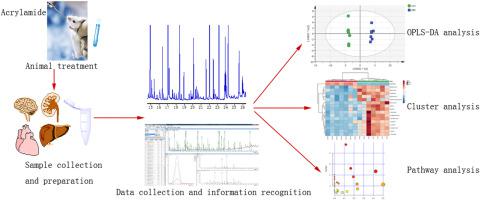当前位置:
X-MOL 学术
›
Environ. Pollut.
›
论文详情
Our official English website, www.x-mol.net, welcomes your
feedback! (Note: you will need to create a separate account there.)
Comprehensive analysis of metabolic changes in rats exposed to acrylamide
Environmental Pollution ( IF 7.6 ) Pub Date : 2021-06-16 , DOI: 10.1016/j.envpol.2021.117591 Shiyuan Zhao 1 , Haitao Zhong 1 , Chunmei Geng 1 , Hongjia Xue 2 , Changshui Wang 3 , Wenxue Sun 1 , Ruili Dang 1 , Wenxiu Han 1 , Pei Jiang 4
Environmental Pollution ( IF 7.6 ) Pub Date : 2021-06-16 , DOI: 10.1016/j.envpol.2021.117591 Shiyuan Zhao 1 , Haitao Zhong 1 , Chunmei Geng 1 , Hongjia Xue 2 , Changshui Wang 3 , Wenxue Sun 1 , Ruili Dang 1 , Wenxiu Han 1 , Pei Jiang 4
Affiliation

|
Acrylamide (ACR) is a widely used environmentally hazardous compound that is known to be neurotoxic, genotoxic, carcinogenic, and reproductive toxicity. It is widely present in soil, water, agents used in chemical industries, and food. It can be distributed to all organs and tissues, and can cause damage to various human systems and those of other animals. Previous metabolomics studies have mainly focused on metabolites in serum and urine, but have lacked comprehensive analysis of major organs and tissues. In the current study, a gas chromatography-massspectrometry method was used to investigate mechanisms underlying organ toxicity, in an effort to identify potentially sensitive biomarkers in the main target tissues of rats after ACR exposure. Male Sprague-Dawley rats were assigned to two groups; a control group and a group treated with 20 mg kg ACR intragastrically for 6 weeks. Metabolite changes in the two groups were statistically analyzed. The respective numbers of altered metabolites in the hippocampus, cortex, kidney, serum, heart, liver, and kidney fat were 21, 21, 17, 5, 15, 14, and 6. There were 14 metabolic pathways related to amino acid, fatty acid, purine, and energy metabolism, revealing that the toxic mechanism of ACR may involve oxidative stress, inflammation, and amino acid metabolism and energy disorders.
中文翻译:

丙烯酰胺染毒大鼠代谢变化综合分析
丙烯酰胺 (ACR) 是一种广泛使用的对环境有害的化合物,已知具有神经毒性、遗传毒性、致癌性和生殖毒性。它广泛存在于土壤、水、化学工业制剂和食品中。它可以分布到所有器官和组织,并对人体和其他动物的各个系统造成损害。以往的代谢组学研究主要集中在血清和尿液中的代谢物,缺乏对主要器官和组织的综合分析。在本研究中,采用气相色谱-质谱法研究器官毒性的机制,旨在鉴定 ACR 暴露后大鼠主要靶组织中潜在敏感的生物标志物。雄性斯普拉格-道利大鼠被分为两组;对照组和20mg/kg ACR灌胃治疗组6周。对两组代谢变化进行统计分析。海马、皮质、肾脏、血清、心脏、肝脏和肾脏脂肪中改变的代谢物数量分别为21、21、17、5、15、14和6。与氨基酸、脂肪相关的代谢途径有14条。酸、嘌呤和能量代谢,揭示ACR的毒性机制可能涉及氧化应激、炎症、氨基酸代谢和能量紊乱。
更新日期:2021-06-16
中文翻译:

丙烯酰胺染毒大鼠代谢变化综合分析
丙烯酰胺 (ACR) 是一种广泛使用的对环境有害的化合物,已知具有神经毒性、遗传毒性、致癌性和生殖毒性。它广泛存在于土壤、水、化学工业制剂和食品中。它可以分布到所有器官和组织,并对人体和其他动物的各个系统造成损害。以往的代谢组学研究主要集中在血清和尿液中的代谢物,缺乏对主要器官和组织的综合分析。在本研究中,采用气相色谱-质谱法研究器官毒性的机制,旨在鉴定 ACR 暴露后大鼠主要靶组织中潜在敏感的生物标志物。雄性斯普拉格-道利大鼠被分为两组;对照组和20mg/kg ACR灌胃治疗组6周。对两组代谢变化进行统计分析。海马、皮质、肾脏、血清、心脏、肝脏和肾脏脂肪中改变的代谢物数量分别为21、21、17、5、15、14和6。与氨基酸、脂肪相关的代谢途径有14条。酸、嘌呤和能量代谢,揭示ACR的毒性机制可能涉及氧化应激、炎症、氨基酸代谢和能量紊乱。











































 京公网安备 11010802027423号
京公网安备 11010802027423号